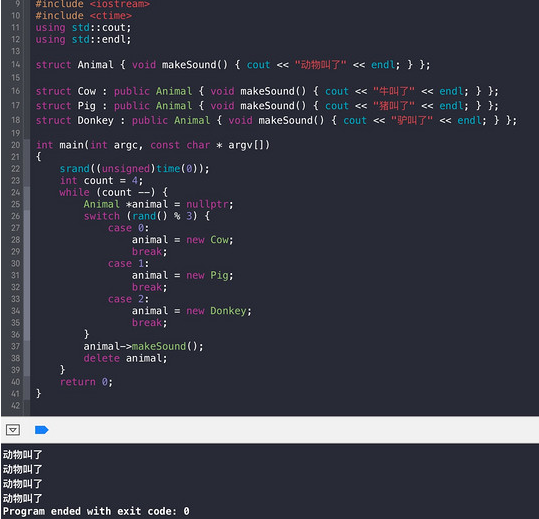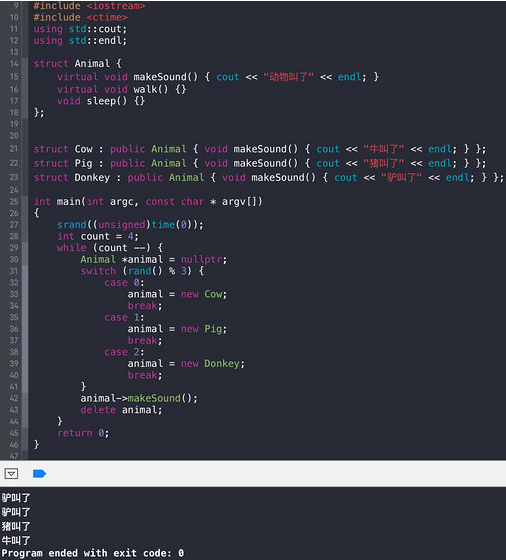C++虚表,你搞懂了吗?
作者:网络转载 发布时间:[ 2016/7/1 10:50:04 ] 推荐标签:.NET 测试开发技术 虚表
前言
我们说的虚表其实有很多种叫法:
· virtual method table(VMT)
· virtual function table(vftable)
· virtual call table
· dispatch table
· vtable
这些都是虚表的意思。虚表是一种利用程序语言实现的dynamic dispatch机制,或者说runtime method binding机制,也是我们说的多态。
注:笔者在本文使用C++语言,并且统一用vTable来表示虚表。
虚函数
用virtual关键字修饰的函数叫虚函数。
因为vTable(虚表)是C++利用runtime来实现多态的工具,所以我们需要借助virtual关键字将函数代码地址存入vTable来躲开静态编译期。这里我们先不深入探究,后面我会细说。
首先我们先来看一个没有虚函数,即没有用到vTable的例子:
#include <iostream>
#include <ctime>
using std::cout;
using std::endl;
struct Animal { void makeSound() { cout << "动物叫了" << endl; } };
struct Cow : public Animal { void makeSound() { cout << "牛叫了" << endl; } };
struct Pig : public Animal { void makeSound() { cout << "猪叫了" << endl; } };
struct Donkey : public Animal { void makeSound() { cout << "驴叫了" << endl; } };
int main(int argc, const char * argv[])
{
srand((unsigned)time(0));
int count = 4;
while (count --) {
Animal *animal = nullptr;
switch (rand() % 3) {
case 0:
animal = new Cow;
break;
case 1:
animal = new Pig;
break;
case 2:
animal = new Donkey;
break;
}
animal->makeSound();
delete animal;
}
return 0;
}
程序中有一个基类Animal,它有一个makeSound()函数。有三个继承自Animal的子类,分别是牛、猪、驴,并且实现了自己的makeSound()方法。很简单的代码,是吧。
我们运行程序,你觉得输出结果会是什么呢?不错,这里会连续执行4次Animal的makeSound()方法,结果如下:

为什么?因为我们的基类Animal的makeSound()方法没有使用Virtual修饰,所以在静态编译时makeSound()的实现定死了。调用makeSound()方法时,编译器发现这是Animal指针,会直接jump到makeSound()的代码段地址进行调用。
ok,那么我们把Animal的makeSound()改为虚函数,如下:
struct Animal {
virtual void makeSound()
{
cout << "动物叫了" << endl;
}
};
运行会是怎样?如你所料,多态已经成功实现:

接下来是大家关心的部分,这是怎么回事?编译器到底做了什么?
虚表
为了说明方便,我们需要修改一下基类Animal的代码,不改变其他子类,修改如下:
struct Animal {
virtual void makeSound() { cout << "动物叫了" << endl; }
virtual void walk() {}
void sleep() {}
};
struct Cow : public Animal { void makeSound() { cout << "牛叫了" << endl; } };
struct Pig : public Animal { void makeSound() { cout << "猪叫了" << endl; } };
struct Donkey : public Animal { void makeSound() { cout << "驴叫了" << endl; } };
相关推荐

更新发布
功能测试和接口测试的区别
2023/3/23 14:23:39如何写好测试用例文档
2023/3/22 16:17:39常用的选择回归测试的方式有哪些?
2022/6/14 16:14:27测试流程中需要重点把关几个过程?
2021/10/18 15:37:44性能测试的七种方法
2021/9/17 15:19:29全链路压测优化思路
2021/9/14 15:42:25性能测试流程浅谈
2021/5/28 17:25:47常见的APP性能测试指标
2021/5/8 17:01:11













 sales@spasvo.com
sales@spasvo.com